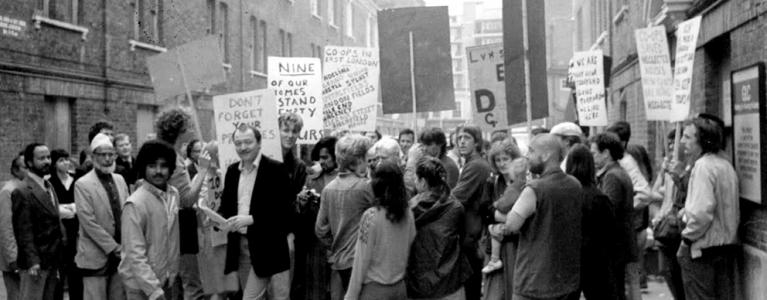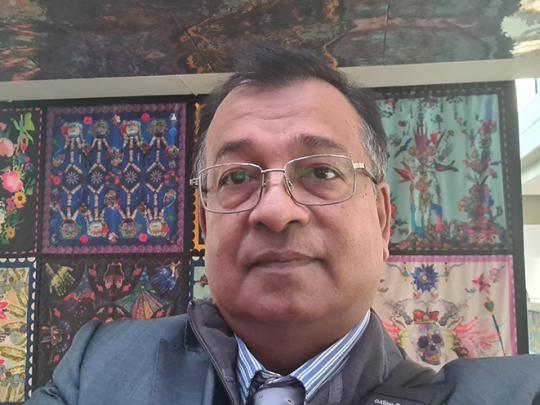
For London Unseen's last blog post of the season, we invited Dr Muhammad Ahmedullah to write about his work on the East End Bangladeshi squatters of the 1970's...
In 2019, I was employed to run a small pilot project on the Bangladeshi Squatters of Parfett Street and Myrdle Street by the East End Connection, a local organisation based in Myrdle Street in East London, funded by the National Lottery Heritage Fund.
In the 1970s, several properties in Parfett Street and Myrdle Street became a battleground between squatters – primarily white artists, teachers, actors, writers and other creative individuals – and property owners. There were protests, evictions and reoccupations, and local papers of the period have coverage of the drama that unfolded in the now quiet streets. Some newspaper headlines in early 1973 were ‘The siege of Myrdle St’, ‘Judge regrets lack of legal backing for ‘good squatters’, ‘Street battle as squatters repel bailiffs and police’ and ‘Marchers locked out by property firm’. Bangladeshis arriving in the East End in the 1960s and 70s found an already existing squatting phenomenon in the area, into which many soon found a route to have a roof over their heads, a home. There existed an understandable justification for such occupation and they were helped by existing squatters and equality campaigners.
Before 2019, I had very little idea of Bangladeshi squatters in the area and their struggles. This is a kind of amnesia and typical experience of many newcomers to an area or young people growing up not knowing much about the past of where they live. There are many reasons for this lack of knowledge and awareness, but there seems to be two main causes why this is so. First, very few people have bothered to collect diverse stories, record them, and explain and educate people so that those who live or interact with an area develop a deeper sense of roots and ownership of the place. Second, academic and research papers – mostly incomplete in terms of the number and varieties of stories relied on - are sitting idly in archives or inside books and journals, seen mainly by researchers occasionally who have very little interest in community education and community ownership of history and heritage.
When I started my work – which involved some archival research, interviews and collection of documents and photographs from local organisations and communities - what I began to discover blew my mind away. I know the area well without ever having lived there, but I had never previously imagined the scale, hardships and drama associated with so many diverse people squatting in the area. Although the project was about Bangladeshi squatters of Parfett Street and Myrdle Street, that story could not be told or understood without knowing the contextual backgrounds of squatting in the area and what went on before and continued throughout the period of Bangladeshi squatting and their fights for housing rights and decent homes.
As soon as I advertised in June 2019 the project launch due to take place in the following month, I received an email from someone called Jubeda Ali, whose family squatted in many nearby places. Jubeda commented:
“I used to be one of the original squatters, but it was in Old Montague Street. Before that, the family also squatted in other places but I’m not sure my mum remembers the names of those streets. I was under 5 during this time. I was born in 1975 and we came to London in 1975 and I’ve been trying to get some history of the early days from my mum. But it’s hard to get parents to tell us their history sometimes so I would like to volunteer my mum (and myself) to participate in recording some of this history. We lived in dilapidated accommodations which were not fit for human habitation. One place didn’t even have floors and mum and dad had to make improvised flooring!”
This was a very touching start to the project, but sadly Jubeda passed away from a terminal illness before we had the opportunity to interview and record her story.
For the project, we interviewed ten individuals, both Bangladeshi and white squatters and some activists who facilitated and supported the Bangladeshi squatters. The experience of racism was a harsh reality for many Bangladeshis, and the fear of violence meant that some squatters preferred to stay in what they described as ‘banga ghor’, broken house, than be rehoused to better accommodation, surrounded by violent racists, which started later.
The stories of the Bangladeshi squatters of Parfett Street and Myrdle Street generated by the project, alongside many more insights into their lived experiences, can be found on the website of East End Connection which I invite you to explore.
---
Muhammad Ahmedullah has lived in the UK since 1973 when he arrived in London as a child from Bangladesh. He completed his early education in Newham, East London, further education in Hendon, Northwest London and higher education at the universities of Essex and Kent, from the latter gaining a PhD in 1998 on the relationship between theory of knowledge and political theory. Most of his career involved working for local councils in central government’s inner city regeneration programmes during 1990 and 2010. Since 2011, he has worked for several non-government organisations delivering projects on history and community cohesion. He also provides a fundraising service for small community and voluntary organisations. He is a founder member of Brick Lane Circle that runs a variety of projects and activities. His personal blog website is culturaluniverse.com, where he also writes a regular blog.
